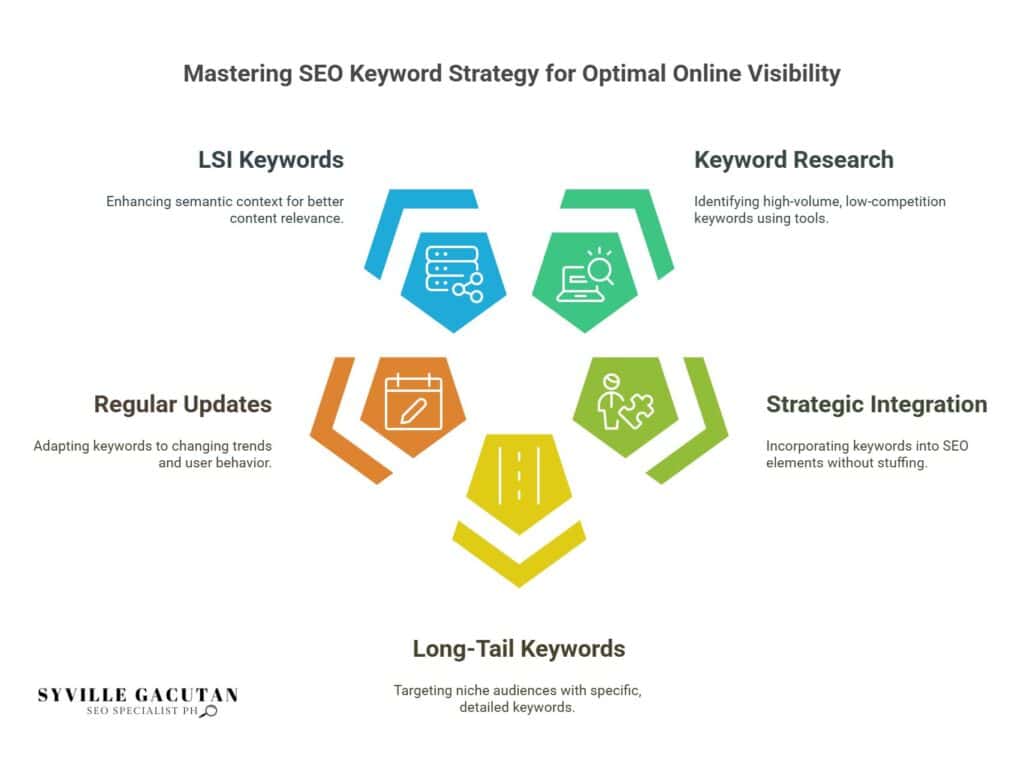
10 Proven Tips: Enhance Website Visibility With Keywords
Enhance your website’s visibility using keywords by tailoring content to your audience and understanding their search patterns. Conduct thorough keyword research with tools like Google Keyword Planner. Focus on long-tail keywords to attract niche audiences. Strategically incorporate keywords in title tags, meta descriptions, and header tags. Utilize Latent Semantic Indexing (LSI) keywords to provide context and improve search relevance. Create keyword-centric content and target high-impact keywords with significant search volume. Regularly update your keywords based on search trends and competitor analysis. Align keywords with user intent to maintain relevance. There are further strategies in improving website visibility through keyword research.
Key Takeaways
- Do thorough research to discover popular words or phrases that many people search for but that few websites target, using tools like Google Keyword Planner and SEMrush to find those with high search volume and low competition.
- Integrate keywords strategically in title tags, meta descriptions, header tags, and body content to optimize SEO without keyword stuffing.
- Utilize long-tail keywords to attract niche audiences and improve conversion rates due to their specificity.
- Regularly update keywords based on evolving search trends and user behaviors to maintain relevance and drive targeted organic traffic.
- Employ LSI keywords to provide semantic context, enhancing search engines’ understanding and improving content relevance for local queries.

1. Understand Your Audience

Getting to know your audience is the first step in enhancing website visibility through the strategic use of keywords. To improve your website’s visibility, especially on Google, it is imperative to have a deep comprehension of the audience you aim to reach. This insight guides your choice of relevant keywords, which are crucial for effective search engine optimization (SEO).
To begin with, identifying the demographics, preferences, and understanding the behaviors of your target audience allows you to customize your content to better meet their specific needs. This involves analyzing factors such as age, location, interests, and online behavior. By knowing who your audience is you can guess the kinds of searches they will do. This helps you craft content that engages with them and gives them what they want.
Moreover, understanding your audience allows you to anticipate their search patterns. This foresight is essential for identifying relevant keywords that they might use. When your website content aligns with these keywords, it significantly enhances your website visibility on Google. For example, if your target audience is looking for “eco-friendly home products,” incorporating this phrase into your content can bring more people to your site.
In terms of search engine optimization, the alignment between your audience’s needs and your content is paramount. SEO is not just about inserting keywords haphazardly; it is about integrating them seamlessly into valuable and relevant content. Your website’s visibility increases with this approach. It also makes sure that visitors find your site helpful and interesting.
2. Research Relevant Keywords

Conducting thorough keyword research is pivotal for enhancing website visibility. To improve your website’s visibility, it is essential to find the right keywords that truly connect with your target audience. This process not only aids in formulating effective SEO strategies but also significantly impacts your search engine ranking.
Here are four key steps to research relevant keywords efficiently:
- Identify Seed Keywords: Start by jotting down a list of basic terms related to your niche. These starting words provide a basis for additional investigation and learning. Utilize tools like Google Keyword Planner or SEMrush to expand on these initial ideas, identifying variations and related terms that users frequently search for.
- Analyze Competitor Keywords: Study the keywords your competitors are targeting. Tools like Ahrefs and Moz can help you uncover the terms that are driving traffic to their websites. By analyzing these keywords, you can identify gaps in your own strategy and discover opportunities to improve your website’s visibility.
- Evaluate Keyword Metrics: Assess the value of each potential keyword using key metrics such as search volume, competition, and relevance. High search volume indicates a popular term, but high competition might make it challenging to rank. Aim for a balance, selecting keywords that are relevant to your content and attainable in terms of search engine ranking.
- Utilize Keyword Research Tools: Leverage advanced keyword research tools to refine your keyword list. Tools like Ubersuggest and KeywordTool.io provide insights into keyword trends, related queries, and long-tail keywords that can enhance your SEO strategies.
3. Use Long-Tail Keywords
Incorporating long-tail keywords into your content strategy can significantly enhance your website’s visibility. Long-tail keywords, which are typically longer and more specific phrases, cater to niche audiences and are less competitive compared to short, generic keywords. By focusing on these specific terms, you can attract highly targeted traffic, leading to a higher likelihood of conversion.
One of the primary benefits of using long-tail keywords is their potential to boost your website’s visibility in search engine results. Since these keywords are more precise, they often face less competition, making it easier to rank higher on search engine results pages (SERPs). For instance, instead of competing for a broad term like “shoes,” you might use a long-tail keyword such as “women’s waterproof hiking shoes,” which narrows down the search intent and increases the chances of appearing in relevant searches.
Additionally, long-tail keywords can improve your website’s visibility by attracting visitors who are further along in the buying process. These users often know exactly what they are looking for and are more likely to engage with your content or make a purchase.
For example, someone searching for “best organic skincare products for acne-prone skin” is likely seeking specific solutions and may be more inclined to trust and act upon the information provided on your website.
4. Incorporate Keywords Strategically

Effectively incorporating keywords into your website content is crucial for enhancing search engine optimization (SEO) and driving organic traffic. To improve your website’s visibility, it is essential to adopt a strategic approach to keyword placement. Properly incorporating keywords strategically can signal to search engine algorithms that your content is relevant and authoritative, which in turn can elevate your rankings in organic search results.
Here are four key strategies to incorporate keywords strategically:
- Title Tags and Meta Descriptions: Ensure that your primary keywords are included in title tags and meta descriptions. These elements are among the first things search engine algorithms evaluate, and they play a significant role in the click-through rate from search engine results pages (SERPs). By embedding keywords in these areas, you provide immediate context to both users and search engines.
- Header Tags (H1, H2, H3): Using keywords in header tags helps structure your content and makes it more readable. Search engines use these tags to understand the hierarchy and relevance of your content. Incorporating keywords in headers not only improves readability but also assists in signaling the main topics to search engines, thereby enhancing effective SEO.
- Content Body: Keywords should naturally flow within the body of your content. Avoid keyword stuffing; instead, focus on incorporating keywords in a way that reads naturally to your audience. This ensures that your content remains engaging and informative while still being optimized for organic search.
- URL Structure: Including keywords in your URLs can improve your website’s visibility. Search engine algorithms consider the URL as part of their ranking criteria. A clean, keyword-rich URL structure can contribute to higher search engine rankings and user trust.
5. Leverage LSI Keywords

Leveraging Latent Semantic Indexing (LSI) keywords is a powerful technique to boost your website’s SEO performance. LSI keywords are terms and phrases that are semantically related to your primary keyword. They help search engines understand the context and content of your website more accurately, thereby improving your website’s visibility in search results.
Incorporating LSI keywords into your website content can significantly enhance search engine visibility. These keywords provide additional context and relevance, making it easier for search engines to determine the subject matter of your content. For instance, if your primary keyword is “digital marketing,” relevant LSI keywords might include “SEO techniques,” “online advertising,” and “content marketing.” By naturally integrating these terms into your content, you create a more comprehensive and contextually rich piece that appeals to search algorithms.
Moreover, LSI keywords can help capture local search traffic. When users search for services or products in a specific area, incorporating geographically relevant LSI keywords can make your content more pertinent to those queries. For example, if your business operates in New York, including phrases like “New York digital marketing” or “SEO services in NYC” can enhance your visibility in local search results.
To effectively leverage LSI keywords, conduct thorough keyword research and identify terms that are contextually related to your primary keywords. Tools like Google’s Keyword Planner, LSI Graph, and SEMrush can provide valuable insights into relevant LSI keywords.
6. Analyze Keyword Competition

Understanding the competitive landscape of keywords is essential for developing a successful SEO strategy. To increase website visibility and improve your website’s visibility, it is necessary to analyze keyword competition thoroughly. This analysis will help you identify which keywords you should target to enhance your search engine ranking and optimize your website for search.
Here are four crucial steps to effectively analyze keyword competition:
- Identify Competitors: Start by identifying the websites that are currently ranking well for the keywords you are considering. Tools like SEMrush, Ahrefs, and Moz can help you find your top competitors and provide insights into their keyword strategies.
- Analyze Keyword Difficulty: Keyword difficulty is a metric that indicates how hard it is to rank for a specific keyword. Using tools such as Moz’s Keyword Explorer or Ahrefs’ Keywords Explorer, you can assess the difficulty score of your chosen keywords. A higher difficulty score means more competition, and you may need to adjust your strategy accordingly.
- Examine Competitor Content: Review the content of your competitors to understand why they are ranking well. Look at the quality, length, and structure of their content, as well as the use of keywords. This will give you a benchmark and highlight areas where you can improve your content to compete more effectively.
- Evaluate Backlink Profiles: Backlinks play a significant role in search engine ranking. Analyze the backlink profiles of your competitors to see which websites are linking to them. Tools like Ahrefs and Majestic can help you identify high-quality backlink sources, providing opportunities for you to build similar or better backlinks.
7. Create Content Around Keywords

Armed with insights from analyzing keyword competition, the next logical step is to create content that effectively incorporates these keywords. This strategic approach not only helps improve your website’s visibility but also enhances user engagement by providing valuable information aligned with what users are actively searching for.
To optimize your website and its content, it is imperative to seamlessly integrate high-ranking keywords into various elements of your content. The key is to maintain a natural flow while ensuring that the keywords are strategically placed. Begin by crafting compelling headlines and subheadings that include primary keywords. This immediately signals to search engines the relevance of your content, aiding in ranking in search results.
Consider the following structure for content development:
| Content Element | Integration Strategy | Example |
| Headline | Include primary keyword | “Top Tips to Improve Your Website’s Visibility” |
| Introduction | Introduce primary and secondary keywords | “Learn how to optimize your website to increase visibility.” |
| Body Text | Distribute keywords naturally throughout text | “Using relevant keywords can significantly boost your ranking in search engines.” |
In addition to textual content, utilize keywords in meta descriptions, image alt texts, and URLs. Consistent use of keywords across these elements sends cohesive signals to search engines, further enhancing your site’s SEO performance.
Creating content that revolves around well-researched keywords serves dual purposes: it attracts search engine algorithms and resonates with your target audience. As you continue to develop content, regularly update it to reflect new keyword trends and maintain its relevance. This dynamic approach will keep your site’s content fresh, engaging, and highly visible, thereby ensuring sustained improvement in search rankings and increased visibility over time.
8. Target High-Impact Keywords

Identifying and targeting high-impact keywords is a crucial component of any successful SEO strategy. These keywords are highly relevant to your business and possess significant search volume, thereby enhancing the likelihood of attracting potential visitors. By focusing on these high-impact keywords, you can improve your website’s visibility on search engines and consequently drive more website traffic.
To effectively target high-impact keywords, consider the following steps:
- Use SEO Tools for Research: Utilizing SEO tools such as Google Keyword Planner, Ahrefs, or SEMrush can provide invaluable insights into which keywords are most relevant and possess the highest search volumes. These tools can help you identify potential high-impact keywords that align with your content and audience.
- Analyze Competitor Keywords: By examining the keywords your competitors are ranking for, you can discover high-impact keywords that you might have overlooked. Competitor analysis enables you to understand the competitive landscape and refine your keyword strategy to target terms that will improve your website’s visibility.
- Focus on Long-Tail Keywords: While high-volume keywords are essential, long-tail keywords often bring more targeted traffic. These keywords are more specific and less competitive, making it easier to rank higher on search engines. Including long-tail keywords in your strategy ensures a well-rounded approach to SEO.
- Monitor and Adjust: SEO is not a one-time task. Continuously monitor the performance of your targeted keywords using analytics tools. Adjust your strategy based on what is working and what isn’t to maintain and improve your website’s visibility over time.
9. Align Keywords with Intent

Aligning keywords with user intent is a fundamental aspect of an effective SEO strategy. The primary objective is to understand what users are looking for when they type specific queries into search engines, and to ensure that your content meets those needs. By aligning keywords with intent, you can significantly improve your website’s visibility and rank higher in search engine results.
User intent can be categorized into three primary types: informational, navigational, and transactional. Informational intent refers to users seeking knowledge or answers to questions. Navigational intent involves users looking for a specific website or page. Transactional intent is when users are ready to make a purchase or complete an action. Identifying and aligning keywords with these intents can help you create content that resonates with your audience, thereby increasing organic traffic.
For instance, if your website offers digital marketing services, targeting keywords such as “how to improve your website’s visibility” addresses informational intent. On the other hand, “best digital marketing agency near me” aligns with navigational intent, and “buy digital marketing services” meets transactional intent. By precisely aligning your content with these different types of intent, your website is more likely to appear on relevant search engine result pages.
Moreover, search engines like Google prioritize content that best matches user intent, making it critical to align keywords appropriately. When done correctly, this strategy not only enhances user satisfaction but also improves your website’s visibility and leads to higher rankings in search engine results. Consequently, mastering this approach can drive significant, highly-targeted organic traffic to your site.
10. Update Keywords Regularly

To maintain and enhance your website’s visibility in search engine results, it is essential to update your keywords regularly. As search trends and user behaviors evolve, the relevance of specific keywords may change. Regularly updating your keywords ensures that your content remains aligned with current search patterns, thereby improving your website’s visibility.
Here are four key steps to effectively update your keywords:
- Monitor Search Trends: Utilize tools like Google Keyword Planner to stay informed about shifts in search volume and trends. By identifying which keywords are gaining or losing popularity, you can adjust your strategy to maintain optimal relevance.
- Analyze Competitor Keywords: Regularly review the keywords your competitors are using. This can provide insights into emerging trends and opportunities you might have overlooked. Tools like SEMrush or Ahrefs can facilitate this process by offering detailed competitor analysis.
- Evaluate Keyword Performance: Use analytics to assess the performance of your current keywords.Determine which keywords are bringing in traffic and which are underperforming. This data-driven approach helps you make informed choices about which keywords to retain, modify, or discard.
- Incorporate Seasonal and Event-Driven Keywords: Certain keywords may become more relevant during specific times of the year or in response to particular events. By incorporating these timely keywords, you can boost your website’s visibility during peak periods of interest.
Regularly updating your keywords isn’t just a routine task but a strategic effort to stay ahead in the competitive digital landscape.
Final Thoughts
Enhancing website visibility through effective keyword research is essential for driving targeted traffic and improving search engine rankings. By understanding your audience and their search intent, you can identify and incorporate high-impact keywords and long-tail phrases that resonate with potential visitors. Strategic placement of these keywords in title tags, meta descriptions, and content ensures both optimization for search engines and a natural flow for readers. Additionally, leveraging LSI keywords and regularly updating your keyword strategy based on trends and competitor analysis further refines your approach.
If you’re ready to boost your website’s visibility with expert keyword strategies, connect with Syville Gacutan, an experienced SEO Specialist in the Philippines. Syville can help you master keyword research, optimize your content, and drive organic traffic. Don’t miss the opportunity to enhance your website’s performance—reach out today!